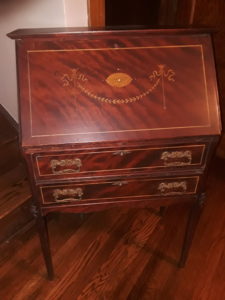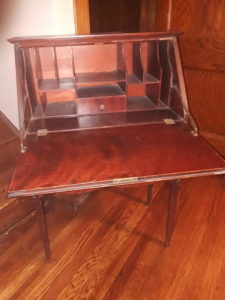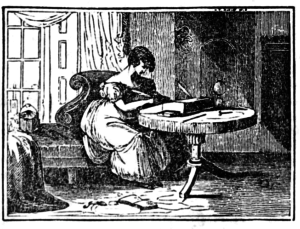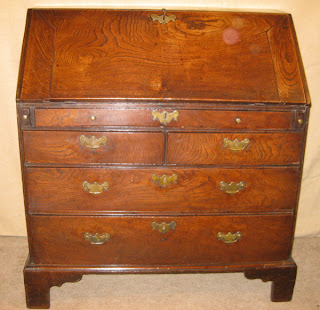 My writing room hasn’t changed too much from the last picture I posted–boxes and boxes of books, still unpacked, alas.
My writing room hasn’t changed too much from the last picture I posted–boxes and boxes of books, still unpacked, alas.
However, I have been making progress on replacing the home office furniture that didn’t make it around the bend in the staircase of my new house: my big desk and a tall bookcase. I have ordered a bunch of stacking, folding bookcases from the Container Store. I had originally thought about ordering bookcases that could be assembled in the room, but then how do I get them out again? These should make it in and out (even though I AM NEVER MOVING AGAIN) and have a lot of good reviews, so I am hoping they will be sturdy enough to hold my writing library and some of my other books as well.
As for the desk, I decided to go back to a local antique store where I’d seen a lovely small desk last winter. My daughter had tried to talk me into buying it then, but it didn’t feel right to buy more furniture while trying to downsize. Luckily for me, the desk was still there, and the already reasonable price had been reduced by about 30%. Maybe it was meant to be.
 Although the nice lady at the store called it “Regency”, I believe, based on the price and its similarity to some of the other vintage/antique furniture I own, that it is no earlier than Edwardian and more likely to be around 1930. Which doesn’t matter to me at all, because 1) I could afford it, 2) it will make it up the stairs, and 3) it’s really pretty! I think it would not have looked out of place in a Regency lady’s drawing room.
Although the nice lady at the store called it “Regency”, I believe, based on the price and its similarity to some of the other vintage/antique furniture I own, that it is no earlier than Edwardian and more likely to be around 1930. Which doesn’t matter to me at all, because 1) I could afford it, 2) it will make it up the stairs, and 3) it’s really pretty! I think it would not have looked out of place in a Regency lady’s drawing room.
 Early “desks” were often just portable writing boxes with a slanted top and a little storage inside, and then could be placed on top of other tables. Here’s an illustration.
Early “desks” were often just portable writing boxes with a slanted top and a little storage inside, and then could be placed on top of other tables. Here’s an illustration.
Jane Austen used a portable desk like the one picture. Here’s a JASNA article about it.
Small desks like mine could be seen as an evolution: adding legs to the portable desk. Here’s an image of a lady from Costume Parisien with a similar small desk, or escritoire. This one is of a type called a “cylinder desk”, a precursor of what we call “roll top” desks.
 Mine can be called a “drop front” or “slant front” desk. Here’s an example of one that is c. 1810, so they were definitely around.
Mine can be called a “drop front” or “slant front” desk. Here’s an example of one that is c. 1810, so they were definitely around.
 Further evolutions of this sort of desk added bookcases above and/or drawers or cabinets below. I have seen all variations sometimes called “escritoires” and sometimes “secretary desks”. The term “secretary” does not refer so much to the occupation as the fact that there were places in the desk to “secret” things away.
Further evolutions of this sort of desk added bookcases above and/or drawers or cabinets below. I have seen all variations sometimes called “escritoires” and sometimes “secretary desks”. The term “secretary” does not refer so much to the occupation as the fact that there were places in the desk to “secret” things away.
Anyway, I am really happy with mine, and looking forward to bringing it upstairs once the bookshelves arrive and I can unpack all the books. In the meantime, I have been going out to local coffee shops to write. I have friends who say they work best in clutter, but I find it distracting and a bit guilt-producing, because I feel I should be cleaning and not writing.
How about you? Can you work in chaos or do you prefer a tidy workspace? Do you have any favorite items in your writing or office space?
Elena



